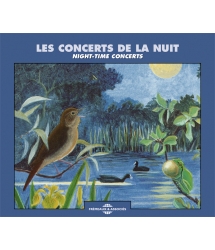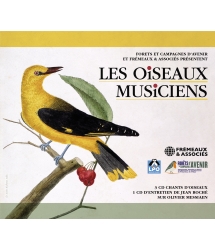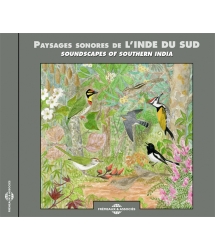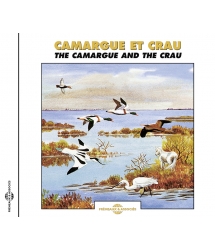- Our Catalog
- Philosophy
- Philosophers of the 20th century and today
- History of Philosophy (PUF)
- Counter-History and Brief Encyclopedia by Michel Onfray
- The philosophical work explained by Luc Ferry
- Ancient thought
- Thinkers of yesterday as seen by the philosophers of today
- Historical philosophical texts interpreted by great actors
- History
- Books (in French)
- Social science
- Historical words
- Audiobooks & Literature
- Our Catalog
- Jazz
- Blues
- Rock - Country - Cajun
- French song
- World music
- Africa
- France
- Québec / Canada
- Hawaï
- West Indies
- Caribbean
- Cuba & Afro-cubain
- Mexico
- South America
- Tango
- Brazil
- Tzigane / Gypsy
- Fado / Portugal
- Flamenco / Spain
- Yiddish / Israel
- China
- Tibet / Nepal
- Asia
- Indian Ocean / Madagascar
- Japan
- Indonesia
- Oceania
- India
- Bangladesh
- USSR / Communist songs
- World music / Miscellaneous
- Classical music
- Composers - Movie Soundtracks
- Sounds of nature
- Our Catalog
- Youth
- Philosophy
- News
- How to order ?
- Receive the catalog
- Manifesto
- Dictionnary











- Our Catalog
- Philosophy
- Philosophers of the 20th century and today
- History of Philosophy (PUF)
- Counter-History and Brief Encyclopedia by Michel Onfray
- The philosophical work explained by Luc Ferry
- Ancient thought
- Thinkers of yesterday as seen by the philosophers of today
- Historical philosophical texts interpreted by great actors
- History
- Books (in French)
- Social science
- Historical words
- Audiobooks & Literature
- Our Catalog
- Jazz
- Blues
- Rock - Country - Cajun
- French song
- World music
- Africa
- France
- Québec / Canada
- Hawaï
- West Indies
- Caribbean
- Cuba & Afro-cubain
- Mexico
- South America
- Tango
- Brazil
- Tzigane / Gypsy
- Fado / Portugal
- Flamenco / Spain
- Yiddish / Israel
- China
- Tibet / Nepal
- Asia
- Indian Ocean / Madagascar
- Japan
- Indonesia
- Oceania
- India
- Bangladesh
- USSR / Communist songs
- World music / Miscellaneous
- Classical music
- Composers - Movie Soundtracks
- Sounds of nature
- Our Catalog
- Youth
- Philosophy
- News
- How to order ?
- Receive the catalog
- Manifesto
- Dictionnary
THE CHORUS OF BIRDS IN THE FOREST OF ISERE, FRANCE
PIERRE HUGUET
Ref.: FA689
Artistic Direction : PIERRE HUGUET
Label : Frémeaux & Associés
Total duration of the pack : 1 hours
Nbre. CD : 1
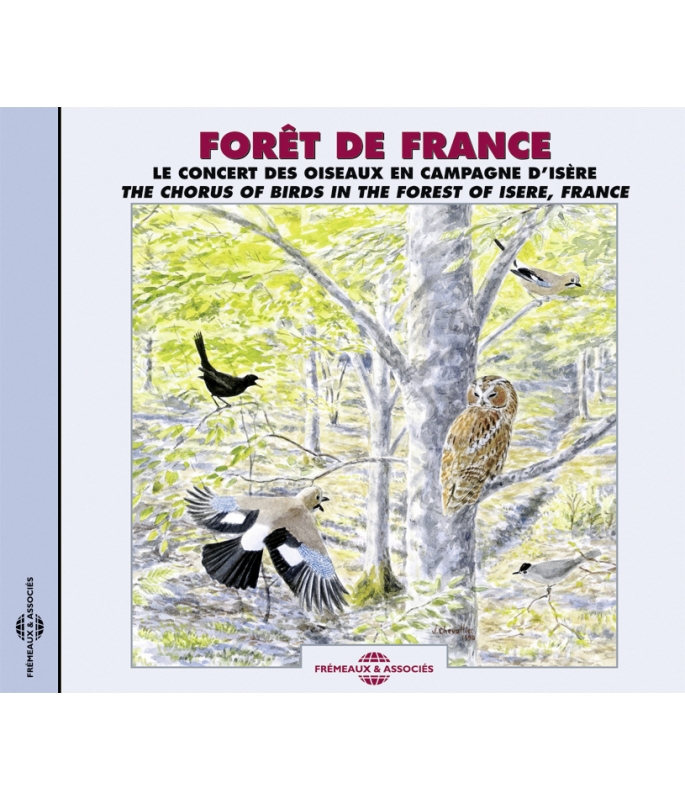
THE CHORUS OF BIRDS IN THE FOREST OF ISERE, FRANCE
THE CHORUS OF BIRDS IN THE FOREST OF ISERE, FRANCE
Transported into the heart of the countryside, up into alpine foothills of Isère in south-eastern France, to the edge of a large clearing, the listener experiences the morning concert of a variety of forest creatures in the springtime. Birds, insects and mammals celebrate the sunshine, mark their territory and salute their friends. The brilliant exuberance of the birds in choir envelops the listener in a magical world. Patrick FRÉMEAUX
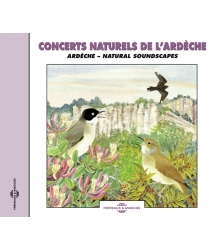
ARDECHE - NATURAL SOUNDSCAPES
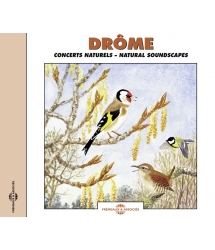
DROME - NATURAL SOUNDSCAPES
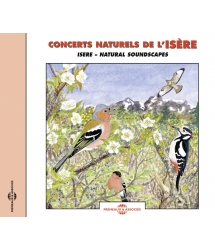
ISERE - NATURAL SOUNDSCAPES



-
PisteTitleMain artistAutorDurationRegistered in
-
1DEBUT DU CONCERTSONS DE LA NATURE00:01:371991
-
2Rougegorge familierRobin (Erithacus rubecula)00:02:221991
-
3Grive musicienneSong Thrush (Turdus philomelos)00:04:101991
-
4Mésange noireCoal Tit (Parus ater)00:02:021991
-
5Coucou gris & merle noirCommon Cuckoo & blackbird00:02:171991
-
6Grive musicienneSong Thrush (Turdus philomelos)00:01:461991
-
7Troglodyte mignonWinter Wren (Troglodytes troglodytes)00:00:491991
-
8Pic épeiche : tambourinageGreat Spotted Woodpecker, drumming (Dendrocopos major)00:01:161991
-
9Pinson des arbresChaffinch (Fringilla coelebs)00:01:421991
-
10Pigeon ramierWood-Pigeon (Columba palumbus)00:02:101991
-
11Tourterelle des boisEuropean Turtle-Dove (Streptopelia turtur)00:01:381991
-
12Mésange noireCoal Tit (Parus ater)00:00:471991
-
13Pouillot véloceCommon Chiffchaff (Phylloscopus collybita)00:04:211991
-
14Geai des chênesEurasian Jay (Garrulus glandarius)00:05:341991
-
15Coucou grisCommon Cuckoo (Cuculus canorus)00:00:351991
-
16Milan noirBlack Kite (Milvus migrans)00:00:271991
-
17Corneille noireCarrion Crow (Corvus corone)00:03:161991
-
18Fauvette à tête noireBlackcap (Sylvia atricapilla)00:05:491991
-
19Corneille noireCarrion Crow (Corvus corone)00:01:041991
-
20Troglodyte mignonWinter Wren (Troglodytes troglodytes)00:01:031991
-
21Pie-grièche écorcheurRed-backed Shrike (Lanius collurio)00:00:421991
-
22Fauvette à tête noireBlackcap (Sylvia atricapilla)00:01:351991
-
23ABOIEMENT DE CHEVREUILROE DEER BARKING00:04:191991
-
24ABOIEMENT DE CHEVREUILROE DEER CALLING AGAIN00:01:221991
-
25Faucon hobereauEurasian Hobby (Falco subbuteo)00:00:331991
-
26Troglodyte mignonWinter Wren (Troglodytes troglodytes)00:01:521991
-
27Milan noirBlack Kite (Milvus migrans)00:05:301991
FORÊT DE FRANCE
FORÊT DE FRANCE
Le concert des oiseaux en campagne d’Isère
The chorus of birds in the forest of Isere, France
Liste des espèces
(numérotés par plages)
1. Début du concert.
Sur la lisière de la forêt, près d’une source. Dans la forêt encore endormie, seuls les hululements des Chouettes hulottes (Strix aluco) se font entendre. Un coq réveille une ferme au loin (5’’). Dans la clairière, des orthoptères font doucement vibrer la prairie le long de la source qui ruisselle en douceur.
2. Rouge-gorge familier (Erithacus rubecula)
Avec l’appui des Chouettes hulottes et des Grives musiciennes, on assite lors des premières lueurs de l’aube au mélange subtil des voix du jour et de la nuit. Le Rouge-gorge est toujours l’un des premiers à se manifester.
3. Grive musicienne (Turdus philomelos)
La forêt se réveille. Merles noirs, Grives musiciennes, Rouge-gorges, Fauvettes à tête noire et Troglodytes forment l’essentiel du fond sonore. En arrière-plan, un Rougequeue noir égrène ses premières notes sur une ruine dans la clairière.
4. Mésange noire (Parus ater)
En arrière-plan : Merle noir, Pigeon ramier, Fauvette à tête noire, Coucou gris, Piegrièche écorcheur, Rougequeue noir, Troglodyte, Mésange charbonnière, Roitelet huppé et Rouge-gorge familier.
5. Coucou gris (Cuculus canorus) et Merle noire (Turdus merula)
En arrière plant : Rouge-gorge familier, Roitelet huppé, Mésange noire, Bruant jaune, Mésange charbonnière, Troglodyte, Mésange bleue, Rougequeue noire, Pinson des arbres, Grive musienne et Tourterelle des bois.
6. Grive musicienne (Turdus philomelos)
Aussitôt chassée par un Merle noir, la Grive reprend son chant à quelque distance. En arrière-plan, un Coucou gris chante au loin, puis un autre sujet plus proche. On retrouve aussi des cris d’inquiétude du Pinson des arbres et les appels très aigus du Roitelet huppé.
7. Troglodyte mignon (Troglodytes troglodytes)
Presque simultanément à cette trille vive et rapide, un Pinson des arbres émet quelques cris d’inquiétude. On reconnaît par ailleurs la Tourterelle des bois, la Grive musicienne, la Fauvette à tête noire, un Coucou gris, le tambourinage du Pic épeiche et le Roitelet huppé.
8. Tambourinage d’un Pic épeiche (Dendrocopos major)
Les pics marquent leur territoire en martelant ainsi certains troncs ou branches sèches résonnant bien sous les coups de bec. Merle noir, Tourterelle des bois, Coucou, Mésange charbonnière, Troglodyte, Grive musicienne et Pigeon ramier se retrouvent dans l’ambiance générale.
9. Pinson des arbres (Fringilla coelebs)
Les strophes sonores des mâles défendant leur territoire nuptial résonnent au printemps dans toute la forêt.
10. Pigeons ramier (Columba palumbus)
Roucoulades sourdes. En arrière-plan : Pinson des arbres, Troglodyte, et Fauvette à tête noire.
11. Tourterelle des bois (Streptopelia turtur)
Le doux roucoulement de cette belle tourterelle migratrice forme un puissant symbole sonore du printemps. En arrière-plan : Grive musicienne, Troglodyte, Fauvette à tête noire, Pigeon ramier, Pinson des arbres et Mésange noire.
12. Mésange noire (parus ater)
Troglodyte, Fauvette à tête noire et Pouillot véloce se remarquent ensuite.
13. Pouillot véloce (phyloscopus collybita)
Hôte des forêts claires, lisières et bocages, le “Compteur d’écus” égrène en de longues séries ses notes caractéristiques faites de deux syllabes alternées. On retrouvera en arrière-plan : Fauvette à tête noire, Troglodyte, Pinson des arbres, Grives musiciennes et Mésange noire.
14. Geai des Chênes (Garrulus glandarius)
Ce cri railleur et enroué signale tous les mouvements inhabituels aux habituant de la forêt. Arrière-plan : Pic Vert, Fauvette à tête noire, Pigeon ramier, Troglodyte, Pinson des arbres, Coucou gris, Merle noir, Grive musicienne, Bruant jaune, Piegrièche écorcheur, Rouge-gorge familier et Mésange charbonnière.
15. Coucou gris (Cuculus canorus)
Egalement : Fauvette à tête noire, Grive, Troglodyte, Merle noir et Milan noir.
16. Milan noir (Milvus migrans)
Des faucons hobereaux adultes dont le nid est tout proche viennent bien vite houspiller cet intrus ; alors que les Roitelet huppé, Grive musicienne, coucou et Pic épeiche (léger martèlement) se font entendre sur la scène.
17. Milan noir (Milvus migrans)
Plusieurs espèces interviennent ensuite en arrière-plan : Fauvette à tête noire, Coucou gris, Grive musicienne, Troglodyte, Mésange noire, Roitelet huppé, Piegrièche écorcheur, Pinson des arbres, Bruant jaune, Sittelle torchepot, Pigeon ramier, Tourterelle des bois et Corneille noire.
18. Corneille noire (Corvus corone)
Arrière-plan : Fauvette à tête noire, Troglodyte, Mésange noire, Tourterelle des bois, Faucon hobereau, Milan noir, Sittelle torchepot, Pouillot véloce, Merle noir, Bruant jaune, Piegrièche écorcheur, Pinson des arbres, Grives musicienne, Coucou gris et Mésange charbonnière.
19. Fauvette à tête noire (Sylvia atricapilla)
Strophes claironnantes, vives et cristallines. Arrière-plan : Pinson des arbres, Merle noir, Mésange charbonnière, Pigeon ramier et Troglodyte.
20. Corneille noire (Corvus corone)
Plusieurs oiseaux se pourchassent en graillant au-dessus des frondaisons. On trouve en arrière-plan les espèces suivantes : Mésange charbonnière, Pinson des arbres, Troglodyte et Fauvette à tête noire.
21. Troglodyte mignon (Troglodytes troglodytes)
Ses trilles aiguës remplissent le sous-bois. Arrière-plan : Troglodyte, Fauvette à tête noire, Coucou dans le lointain puis plus près, cris sec d’un Pic épeiche, Bruant jaune et Piegrièche écorcheur.
22. Piegrièche écorcheur (Lanius excubitor)
Un mâle posté non loin de la lisière émet un petit cri enroué, évoquant un moineau. On retrouve en arrière-plan : Fauvette à tête noire, Troglodyte, Bruant jaune à distance, Coucou gris et Grive musicienne.
23. Fauvette à tête noire (Sylvia atricapilla)
Strophes vigoureuses. Arrière-plan : Troglodyte, Grive musicienne, Mésange charbonnière, Pouillot véloce au loin, Pic épeiche, Corneille noire, Bouvreuil pivoine (appels très doux), Pinson des arbres, Bruant jaune et Coucou gris.
24. Aboiement de Chevreuil (Capreolus capreolus)
Arrière-plan : Coucou gris, Corneille noire, Bruant jaune, Grive musicienne, Fauvette à tête noire, Roitelet huppé, Piegrièche écorcheur, Troglodyte et Pigeon ramier.
25. Aboiement de Chevreuil (Capreolus capreolus)
En arrière-plan : Grive musicienne, Troglodyte, Faucon hobereau, grillons, Corneille noire et Fauvette à tête noire.
26. Faucon hobereau (Falco subbuteo)
Rare en Isère, ce beau rapace se fait remarquer par les appels des adultes volant autour de leur nid. On retrouve en arrière-plan : Chevreuil, Grive musicienne, Troglodyte, Corneille noire, Fauvette à tête noire et Mésange charbonnière.
27. Troglodyte mignon (Troglodytes troglodytes)
Trilles toujours vives, au timbre aigu. Arrière-plan : Fauvette à tête noire, Pinson des arbres, Grive musicienne, Corneille noire, Merle noir, Pigeon ramier et Mésange charbonnière.
Au cœur de l’Isère, entre Lyon et Grenoble ou Saint-Marcellin et Voiron, le pays Antonin étale ses collines et forêts à quelques distances des premières falaises du Vercors. Le massif forestier de Chambaran recouvre les hauteurs autour de Roybon, Saint-Pierre de Bressieux et Saint-Étienne de Saint-Geoir. Ce disque a été enregistré durant plusieurs séances espacées sur le printemps et l’été 1990, mais toujours au même emplacement, en bordure d’une grande clairière à proximité du hameau de Brion. Les enregistrements ont été réalisés sur un magnétophone de type R DAT associé à deux microphones B.&K. 4006.
Une réalisation de Pierre Huguet
Textes écrits par Olivier Tostain
Illustrations réalisées par Jean Chevallier (pour la couverture) et Alexis Nouailhat (pour l’intérieur du livret)
Répertoire alphabétique des espèces audibles dans ce concert et index des indices. Les indices d’accès direct sont indiqués en gras, alors qu’en italique sont présentés les indices des plages sonores où l’espère apparaît postérieurement ou en arrière-plan.
Oiseaux
Bouvreuil pivoine, Pyrrhula pyrrhula : 23.
Bruant jaune, emberiza citrinella : 5, 14, 17, 18, 21, 22, 23, 24.
Corneille noire, Corvus corone : 17, 18, 20, 23, 24, 25, 26, 27.
Coucou gris, Culculus canorus : 4, 5, 6, 7, 8, 14, 15, 16, 17, 18, 21, 22, 23, 24.
Faucon hobereau, Falco subbuteo : 16, 18, 25, 26.
Fauvette à tête noire, Sylvia atricapilla : 3, 4, 7, 10, 11, 12, 13, 14, 15, 17, 18, 19, 20, 21, 22, 23, 24, 25, 26, 27.
Geai des chênes, Garrulus glandarius : 14.
Grive musicienne, Turdus philomelos : 2, 3, 5, 6, 7, 8, 11, 13, 14, 15, 16, 17, 18, 22, 23, 24, 25, 26, 27.
Merle noir, Turdus merula : 3, 4, 5, 6, 8, 14, 15, 18, 19, 27.
Mésange bleue, Parus caeruleus ; 5.
Mésange charbonnière, Parus major : 4, 5, 8, 14, 18, 19, 20, 23, 26, 27.
Mésange noire, Parus ater : 4, 5, 11, 12, 13, 17, 18.
Milan noir, Milvus migrans : 16, 17, 18.
Pic épeiche, Dendrocopos major : 7, 8, 16, 21, 23.
Pic vert, Picus veridis : 14.
Piegrièche écorcheur, Lanius collurio : 4, 14, 17, 18, 21, 22, 24.
Pigeon ramier, Columba palumbus : 4, 7, 8, 10, 11, 14, 17, 18, 19, 20, 23, 27.
Pinson des arbres, Fringilla coelebs : 5, 6, 7, 9, 10, 11, 13, 14, 17, 18, 19, 20, 23, 27.
Pouillot véloce, Phyloscopus collybita : 12, 13, 18, 23.
Roitelet huppé, Regulus regulus : 4, 5, 6, 7, 16, 17, 24.
Rouge-gorge familier, Erithacus rubecula : 2, 3, 4, 5, 14.
Rougequeue noir, Phoenicurus ochruros : 3, 4, 5.
Sittelle torchepot, Sitta europea : 17, 18.
Tourterelle des bois, Streptopellia turtur : 5, 7, 8, 11, 17, 18.
Troglodyte mignon, Troglodytes troglodytes : 3, 4, 5, 7, 8, 10, 11, 12, 13, 14, 15, 17, 18, 19, 20, 21, 22, 23, 24, 25, 26, 27.
Mammifères
Chevreuil, Capreolus capreolus : 24, 25, 26.
English notes
1. Starting point: woodland atmosphere.
A spring gurgles on the edge of a still sleeping wood. One can only hear the moody hooting of Tawny Owls (Strix aluco) and, near us, in a grassy clearing, the stridulations of bushcrickets.
2. Robin (Erithacus rubecula)
The coming of dawn is heralded by the calls of Tawny Owls and the trilling of Song Thrushes together with a subtle blend of both day and night voices.
3. Song Thrush (Turdus philomelos)
The wood awakes. Blackbirds, Song Thrushes, Robins, Blackcaps, and Wrens provide the essential background concert.
A black Redstart experiments with some initial notes from the vantage point of a ruin in the clearing.
4. Mésange noire (Parus ater)
Plus the Blackbird, Woodpigeon, Blackap, cuckoo, Red-backed Shrike, Black redstart, Wren, Great Tit, Goldcrest and Robin.
5. Cuckoo (Cuculus canorus) and Blackbird (Turdus merula)
Plus the Robin, Goldcrest, Coal Tit, Yellowhammer, Great Tit, Wren, Blue Tit, Black Redstart, Chaffinch, Song Thrush and Turtle Dove.
6. Song Thrush (Turdus philomelos)
Chased off by a Blackbird, the Song Thrush takes its song further away. Plus the Cuckoo (at first far off, then a second one closer), Chaffinch (alarm calls), and Goldcrest.
7. Wren (Troglodytes troglodytes)
Almost simultaneous to his fast and lively trill, a Chaffinch calls out with worry. Listen to the Turtle Dove, Song Thrush, Blackcap, Wren, Cuckoo, Goldcrest and drumming of the GFreat Spotted Woodpecker in the Background.
8. Great Spotted Woodpecker (Dendrocopos major) drumming
Woodpeckers mark their territory by drumming certain tree trunks or dead timber which resounds effectively under rapid hammering.
9. Chaffinch (Fringilla coelebs)
Its strong phrases mix with the gentle gurgling of the stream.
10. Woodpigeon (Columba palumbus)
Plus Chaffinch, Wren and Blackcap.
11. Turtle Dove (Streptopelia turtur)
The soft cooing of this attractive summer visitor, whose distinctive call is well known in our woods and countryside. Plus the Song Thrush, Wren, Blackcap, Woodpigeon, Chaffinch and Coal Tit.
12. Coal Tit (parus ater)
With the participation of a Wren, Blackcap and Chiffchaff.
13. Chiffchaff (phyloscopus collybita)
In the background: Blackcap, Wren, Chaffinch, Song Thrush and Coal Tit.
14. Jay (Garrulus glandarius)
The mocking, hoarse call of this bird signals warns all the woodland creatures that something is happening. Plus the green Woodpecker, Blackcap, Woodpigeon, Wren, Chaffinch, Cuckoo, Blackbird, Song Thrush, Yellowhammer, Red-backed Shrike, Robin and Great Tit.
15. Cuckoo (Cuculus canorus)
Listen to the Blackcap, Wren, Song Thrush, Blackbird, Yellowhammer, and Black Kite in the background.
16. Black Kite (Milvus migrans)
Goldcrest, Song Thrush and Great Spotted Woodpecker (lightly tapping) can also be heard on the scene.
17. Black Kite (Milvus migrans)
Many different species are singing together in the background: Blackcap, Cuckoo, Song Thrush, Wren, Coal Tit, Goldcrest, Red-backed Shrike, Chaffinch, Yellowhammer, Nuthatch, Woodpigeon, turtle Dove and Carrion Crow.
18. Carrion Crow (Corvus corone)
Listen to the Blackcap, Wren, Coal Tit, Turtle Dove, Hobby, Black Kite, Nuthatch, Chiffchaff, Blackbird, Yellowhammer, Red-backed Shrike, Chaffinch, Song Thrush, Cuckoo and Great Tit.
19. Blackcap (Sylvia atricapilla)
Plus the Chaffinch, Blackbird, Great Tit, Woodpigeon and Wren.
20. Carrion Crow (Corvus corone)
Several birds noisily chase each other over the treetops. Plus: Great Tit, Chaffinch, Wren and Blackcap.
21. Wren (Troglodytes troglodytes)
The high-pitched trilling of the Wren fill the undergrowth. Plus the Wren, Blackcap, a Cuckoo (at first far off, then closer), and the quick calls of the Great Spotted Woodpecker, a Yellowhammer and a Red-backed Shrike.
22. Red-backed Shrike (Lanius excubitor)
A cock posted not far from the edge of the wood sends out a short, hoarse call, like that of a Sparrow. Plus the Blackcap, Wren, Cuckoo, Song Thrush and further off a Yellowhammer.
23. Blackcap (Sylvia atricapilla)
Plus a Wren, Song Thrush, Great Tit, Chiffchaff far off, Great Spotted Woodpecker, Carrion Crow, Bullfinch (with its very softly calls), Chaffinch, Yellowhammer and Cuckoo.
24. Roe Deer barking (Capreolus capreolus)
Plus the Cuckoo, Carrion Crow, Yellowhammer, Song Thrush, Blackcap, Goldcrest, Red-backed Shrike, Wren and Woodpigeon.
25. Roe Deer calling again (Capreolus capreolus)
Plus the Song Thrush, Wren, Hobby, crickets, Carrion Crow and Blackcap.
26. Hobby (Falco subbuteo)
Adults calling as they fly around their nest. Plus the Roe Deer, Song Thrush, Wren, Carrion Crow, Blackcap and Great Tit.
27. Wren (Troglodytes troglodytes)
Plus the Blackcap, Chaffinch, Song Thrush, Carrion Crow, Blackbird, Woodpigeon and Great Tit.
© 2011 Frémeaux & Associés
At the heart of the Isère department, between Grenoble and Lyon, Saint-Marcellin and Voiron, at the foot of the Vercors cliffs, lies a stretch of hills and forests centred around the abbey at Saint-Antoine. The forest of Chambaran covers the high ground around Roybon, Saint-Pierre de Bressieux and Saint-Étienne de Saint-Geoirs. The recordings presented here were made during several separate sessions during the spring and summer of 1990. The site, on the edge of a clearing close to the hamlet at Brion, was the same throughout. The recordings were made on an R DAT type recorder with two B.&K. 4006 microphones.
Recorded by Pierre Huguet
Texts writing by Olivier Tostain
Illustrations by Jean Chevallier (cover) and Alexis Nouailhat (interior of the booklet)
Alphabetical list of the audible species in this concert, and Reference index :
BIRDS
Black Kite, Milvus migrans: 16, 17, 18.
Black Redstart, Phoenicurus ochruros: 3, 4, 5.
Blackbird, Turdus merula: 3, 4, 5, 6, 8, 14, 15, 18, 19, 27.
Blackcap, Sylvia atricapilla: 3, 4, 7, 10, 11, 12, 13, 14, 15, 17, 18, 19, 20, 21, 22, 23, 24, 25, 26, 27.
Blue Tit, Parus caeruleus: 5.
Bullfinch, Pyrrhula pyrrhula: 23.
Carrion Crow, Corvus corone: 17, 18, 20, 23, 24, 25, 26, 27.
Chaffinch, Fringilla coelebs: 5, 6, 7, 9, 10, 11, 13, 14, 17, 18, 19, 20, 23, 27.
Chiffchaff, Phyloscopus collybita: 12, 13, 18, 23.
Coal Tit, Parus ater: 4, 5, 11, 12, 13, 17, 18.
Cuckoo, Culculus canorus: 4, 5, 6, 7, 8, 14, 15, 16, 17, 18, 21, 22, 23, 24.
Goldcrest, Regulus regulus: 4, 5, 6, 7, 16, 17, 24.
Great Tit, Parus major: 4, 5, 8, 14, 18, 19, 20, 23, 26, 27.
Great Spotted Woodpecker, Dendrocopos major: 7, 8, 16, 21, 23.
Green Woodpecker, Picus veridis: 14.
Hobby, Falco subbuteo: 16, 18, 25, 26.
Jay, Garrulus glandarius: 14.
Nuthatch, Sitta europea: 17, 18.
Red-backed Shrike, Lanius collurio: 4, 14, 17, 18, 21, 22, 24.
Robin, Erithacus rubecula: 2, 3, 4, 5, 14.
Song Thrush, Turdus philomelos: 2, 3, 5, 6, 7, 8, 11, 13, 14, 15, 16, 17, 18, 22, 23, 24, 25, 26, 27.
Tawny Owl, Strix aluco: 1, 2.
Turtle Dove, Streptopellia turtur: 5, 7, 8, 11, 17, 18.
Wood Pigeon, Columba palumbus: 4, 7, 8, 10, 11, 14, 17, 18, 19, 20, 23, 27.
Wren, Troglodytes troglodytes: 3, 4, 5, 7, 8, 10, 11, 12, 13, 14, 15, 17, 18, 19, 20, 21, 22, 23, 24, 25, 26, 27.
Yellowhammer, emberiza citrinella: 5, 14, 17, 18, 21, 22, 23, 24.
MAMMALS
Roe Deer, Capreolus capreolus: 24, 25, 26.
CD FORÊT DE FRANCE © Frémeaux & Associés / Droits audio : Frémeaux & Associés - La Librairie Sonore (Producteur initial : Sittelle, Pithys, Collection Allain Bougrain Dubourg ou Ceba) / Ecouter les chants d'oiseaux sur CD : Sons et ambiances naturelles des écosystèmes - Stéreo and digital recording of the natural landscape sound. Natural sound sceneries of écosystems, Voices of the Wild Life. Les droits de cet enregistrement sont protégés par la loi. Pour toute exploitation d’illustration sonore sur CD, DVD, CD-Rom, Télévision, Cinéma, Sites internet, scénographies (théâtre, musées…), l’autorisation et un devis gratuit peuvent être obtenus auprès de Frémeaux & Associés – fax : +33 (0)1 43.65.24.22 info@fremeaux.com
